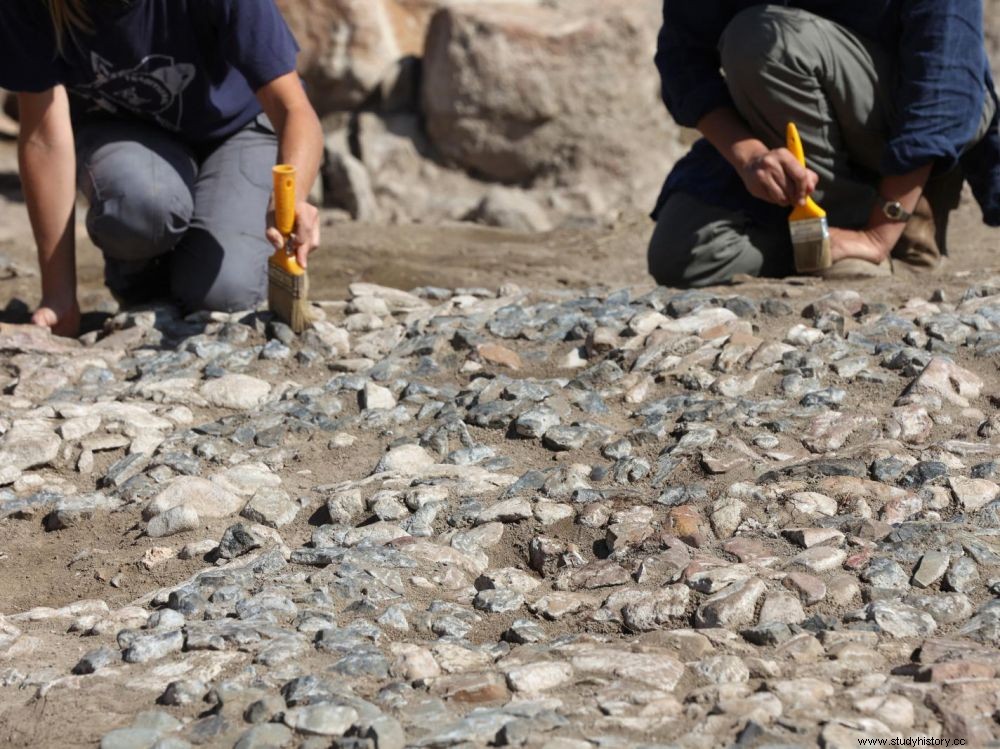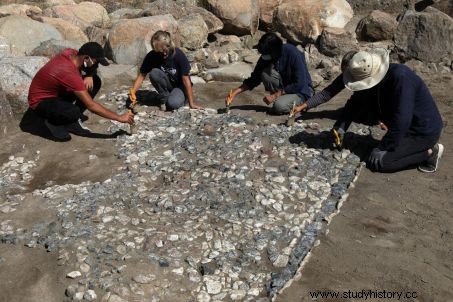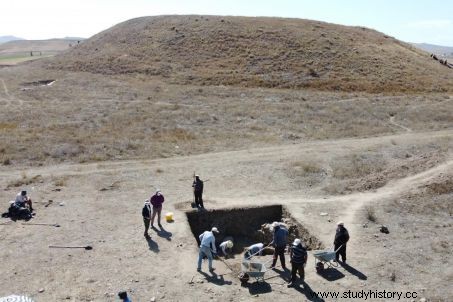The discovery of a 3,500-year-old cobblestone, considered the "ancestor" of Mediterranean mosaics and resting in the remains of a lost city in central Turkey, sharpens knowledge about the daily life of the still mysterious Hittites from the Bronze Age.

Archaeologists work on the remains of a Hittite palace with its luxurious ceramics and glassware, discovered at the Usakli Hoyuk site, near Yozgat, Turkey, September 21, 2021.
An assemblage of more than 3,000 stones, in natural shades of beige, red and black, arranged in triangles and curves, has been unearthed near Yozgat, in present-day Turkey, in the traces of a Hittite temple from the 15th century before AD, i.e. 700 years before the oldest known mosaics of Greek antiquity. "This is the ancestor of antique mosaics, which are obviously more sophisticated. What we have here is probably the first attempt to use this technique" , enthuses Anacleto D'Agostino, director of the excavations at Usakli Hoyuk, the name of the site present.

On this site three hours from Ankara, the Turkish capital, Turkish and Italian archaeologists wield shovels and paintbrushes to learn more about the Hittite localities, one of the most powerful kingdoms of ancient Anatolia. "For the first time, these people felt the need to do something different, with geometric figures, by putting the colors together, instead of making a simple cobblestone. Maybe the builder was a genius? Or that he was ordered a floor covering and he decided to do something unusual ", he explains.
The Shadow of the Lost City of Zippalanda
Located opposite Mount Kerkenes, the temple that housed this mosaic sketch was dedicated to Teshub, the storm god venerated by the Hittites, the equivalent of Zeus among the Greeks. "It is probably here that the Hittite priests performed their rituals while gazing at the summit of Mount Kerkenes" , says the archaeologist. In addition to the mosaic, the archaeologists also discovered ceramics from a palace, confirming the hypothesis that Usakli Hoyuk is indeed the lost city of Zippalanda.
A major place of worship dedicated to the god of the Storm, regularly mentioned in Hittite tablets, the exact location of Zippalanda remains mysterious to this day. “Researchers agree that Usakli Hoyuk is one of the two most likely sites. With the discovery of the remains of the palace and its luxurious ceramics and glassware, this probability is reinforced. We only lack the proof ultimate:a tablet bearing the name of the city" , says Mr. D'Agostino.

The treasures of Usakli Hoyuk, whose inhabitants did not hesitate to bring cedars from Lebanon to build their temples and palaces, were swallowed up like the rest of the Hittite world, for an as yet unexplained reason, towards the end of the bronze age. Among the hypotheses of this collapse, that of a change in the climate accompanied by social unrest.
The "Hittite" fantasy
Nearly 3,000 years after their disappearance from the face of the Earth, the Hittites continue to inhabit the imagination of the Turks. A Hittite figure representing the sun is the symbol of Ankara. In the 1930s, the founder of modern Turkey, Mustafa Kemal Ataturk, presented the Turks as the direct descendants of the Hittites. “I don't know if we can find a connection between the Hittites and the people who live here today. spiritual connection" , smiles the archaeologist.
As if to honor this link, the excavation team has reconstructed Hittite culinary traditions, trying out ancient recipes on ceramics made identically, with the technique and clay used at the time. "We reconstituted the Hittite ceramics with clay found in the village where the site is located:we baked dates and bread on them, as the Hittites used to eat them", reports Valentina Orsi, the co-director Searches. "And it was very good" , she says.
